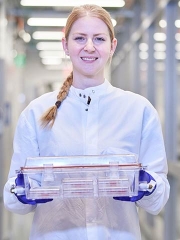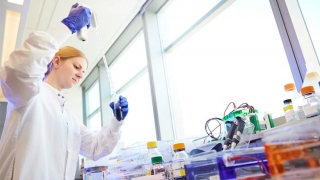A Day in the Life: Petra Molnar, PhD
Published on
Children's ViewPublished on
Children's View As a research trainee in Dr. John’s lab, Dr. Molnar studies metabolic regulators to develop promising antimalarial therapies.
Petra Molnar, PhD, is a postdoctoral fellow under the mentorship of Audrey Odom John, MD, PhD, Chief of the Division of Infectious Diseases. Dr. John primarily studies metabolism as it relates to pediatric infections like malaria, which most often affects children under the age of 5 and — despite existing therapies — causes approximately a half million deaths each year. As a research trainee in Dr. John’s lab, Dr. Molnar studies metabolic regulators to develop promising antimalarial therapies. This is a day in her life.
As a research trainee in Dr. John’s lab, Dr. Molnar studies metabolic regulators to develop promising antimalarial therapies.
Petra Molnar, PhD, is a postdoctoral fellow under the mentorship of Audrey Odom John, MD, PhD, Chief of the Division of Infectious Diseases. Dr. John primarily studies metabolism as it relates to pediatric infections like malaria, which most often affects children under the age of 5 and — despite existing therapies — causes approximately a half million deaths each year. As a research trainee in Dr. John’s lab, Dr. Molnar studies metabolic regulators to develop promising antimalarial therapies. This is a day in her life.
6:30 a.m. Enjoys breakfast — egg on English muffin with coffee — before the short walk to CHOP’s Ruth and Tristram Colket, Jr. Translational Research Building.
8:30 a.m. Checks emails and reviews her to-do list.
9:30 a.m. Attends a weekly Experimental Meeting, moderated by Dr. John, at which research trainees present the results of recent experiments. Dr. Molnar presents her latest figures for a research article in progress.
10:30 a.m. Dons her lab coat and gloves and heads to the lab to make sure the batch of blood she prepared for testing yesterday is free of contaminants and thus safe to use for culturing. Culturing is a way to allow microbial organisms — like malaria parasites — to multiply, using an artificial medium (a culture) that contains the necessary nutrients and temperature for growth.
Because the malaria parasite infects a host’s red blood cells, blood is the lab’s most precious commodity.
 11 a.m. Time for culture care, which includes “feeding” the cultures a nutrient-rich substance and counting the red blood cells through a microscope to determine the amount and condition of the malaria parasites. Some of the cultures will be used in tomorrow’s experiment, in which Dr. Molnar will test three different treatments to determine how each affects the parasites.
11 a.m. Time for culture care, which includes “feeding” the cultures a nutrient-rich substance and counting the red blood cells through a microscope to determine the amount and condition of the malaria parasites. Some of the cultures will be used in tomorrow’s experiment, in which Dr. Molnar will test three different treatments to determine how each affects the parasites.
Dr. Molnar is currently studying a biochemical pathway by which the malaria parasite regulates its metabolism to maintain function. If scientists can figure out how to block that pathway – through gene editing, for example – the parasite won’t be able to survive inside a human body.
1 p.m. Cleans the lab space. Lunch is pasta, veggies and chicken packed from home.
1:30 p.m. In preparation for another experiment, Dr. Molnar extracts the DNA of a genetically modified parasite to ensure it contains the newly added gene. PCR, a lab technique also used for COVID-19 testing, uses temperature cycling to rapidly produce copies of a specific segment of DNA so it can be studied in greater detail.
2:30 p.m. While the PCR test runs, Dr. Molnar checks her email, updates her meticulous lab notes and knocks out some reading. An important aspect of her work includes article publication. She is currently working on two articles and is completing experiments that will inform a third.
4:30 p.m. Checks the PCR test using a gel imaging system. A special dye causes DNA segments to glow when viewed above a UV light source. The presence of a glow indicates the presence of the gene. Now that she’s verified the parasite’s DNA contains the added gene, she can start planning experiments to determine how the genetically modified parasites grow and react to certain drugs.
5 p.m. Before going home, Dr. Molnar hits the gym for an hourlong run to disconnect from the workday.
6:30 p.m. Dinner is shrimp and salad with her boyfriend, Victor. They talk about their days while playing with their cat, Henry.
10 p.m. Meditation before bed and 30 minutes without screens help her wind down for a good night’s sleep.
To support CHOP’s important research into infectious diseases, contact Mike Byun at byunm@chop.edu.